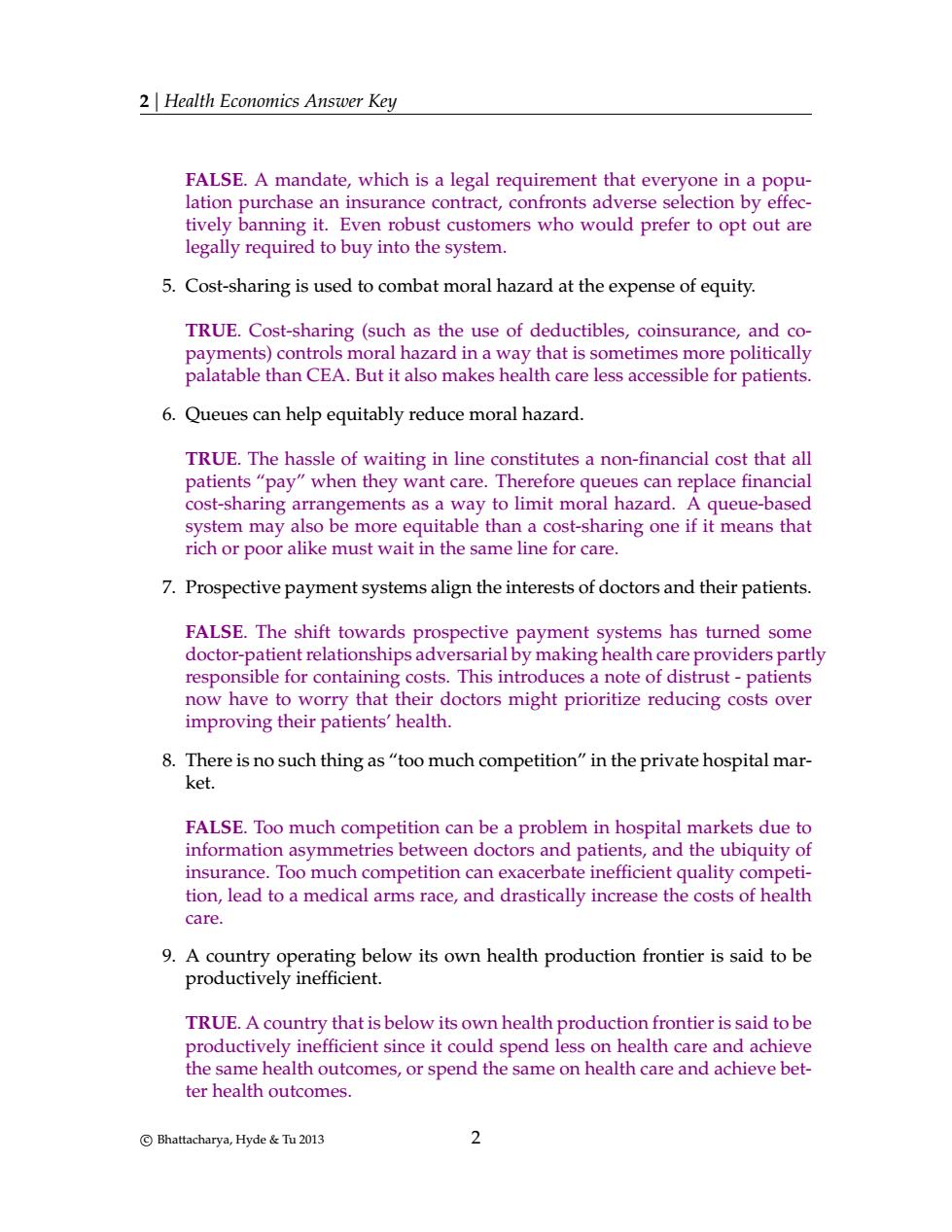正在加载图片...

2Health Economics Answer Key FALSE.A mandate,which is a legal requirement that everyone in a popu- lation purchase an insurance contract,confronts adverse selection by effec- tively ba g it.Even robust custor ers who would prefer to opt out are legally required to buy into the system 5.Cost-sharing is used to combat moral hazard at the expense of equity. TRUE.Cost-sharing (such as the use of deductibles,coinsurance,and co payments)controls moral hazard in a way that is sometimes more politically palatable than CEA.But it also makes health care less accessible for patients. 6.Queues can help equitably reduce moral hazard TRUE.The hassle of waiting in line constitutes a non-financial cost that all patients"pay"when they want care.Therefore queues can replace financial cost-sharing arrangements as a way to limit moral hazard.A queue-based may also be more equitable than a cost-sharing one r alike r must wait in the same line for care. 7.Prospective payment systems align the interests of doctors and their patients. FALSE.The shift towards prospective payment systems has turned some nt rela rial by making health ote of d e pro vid ers partly ining costs This introduces a n t-patient now have to worry that their doctors might prioritize reducing costs over improving their patients'health. 8 There is no such thing as"too much competition"in the private hospital mar ket. FALSE.Too much competition can be a problem in hospital markets due to information asymmetries between doctors and patients,and the ubiquity of insurance.Toomuch competition can exacerbate inefficient qualty com npeti. tion,lead to a medical s race,and drastically increase care. 9.A country operating below its own health production frontier is said to be producti vely inefficient. TRUE.A country that is below its own health production frontier is said to be productively inefficient since it could spend less on health care and achieve the same health outcomes,or spend the same on health care and achieve bet- ter health outcomes. Bhattacharya,Hyde Tu 2013 2 2 | Health Economics Answer Key FALSE. A mandate, which is a legal requirement that everyone in a population purchase an insurance contract, confronts adverse selection by effectively banning it. Even robust customers who would prefer to opt out are legally required to buy into the system. 5. Cost-sharing is used to combat moral hazard at the expense of equity. TRUE. Cost-sharing (such as the use of deductibles, coinsurance, and copayments) controls moral hazard in a way that is sometimes more politically palatable than CEA. But it also makes health care less accessible for patients. 6. Queues can help equitably reduce moral hazard. TRUE. The hassle of waiting in line constitutes a non-financial cost that all patients “pay” when they want care. Therefore queues can replace financial cost-sharing arrangements as a way to limit moral hazard. A queue-based system may also be more equitable than a cost-sharing one if it means that rich or poor alike must wait in the same line for care. 7. Prospective payment systems align the interests of doctors and their patients. FALSE. The shift towards prospective payment systems has turned some doctor-patient relationships adversarial by making health care providers partly responsible for containing costs. This introduces a note of distrust - patients now have to worry that their doctors might prioritize reducing costs over improving their patients’ health. 8. There is no such thing as “too much competition” in the private hospital market. FALSE. Too much competition can be a problem in hospital markets due to information asymmetries between doctors and patients, and the ubiquity of insurance. Too much competition can exacerbate inefficient quality competition, lead to a medical arms race, and drastically increase the costs of health care. 9. A country operating below its own health production frontier is said to be productively inefficient. TRUE. A country that is below its own health production frontier is said to be productively inefficient since it could spend less on health care and achieve the same health outcomes, or spend the same on health care and achieve better health outcomes. c Bhattacharya, Hyde & Tu 2013 2